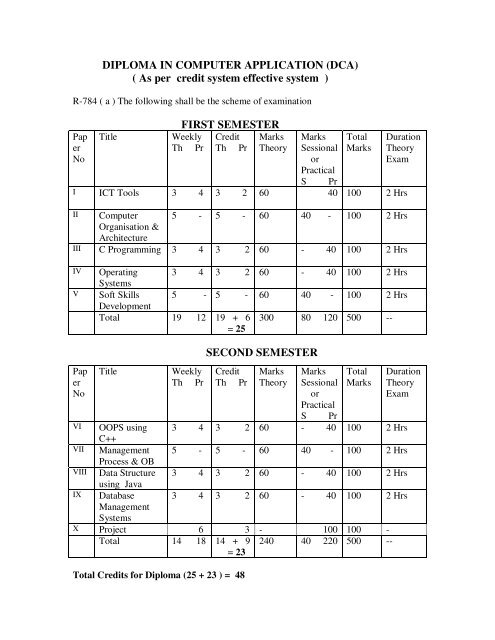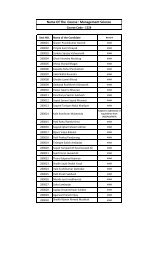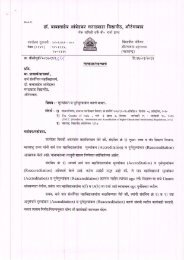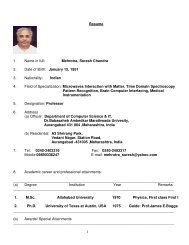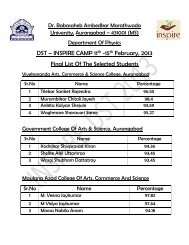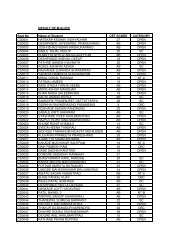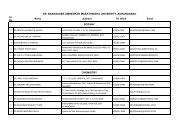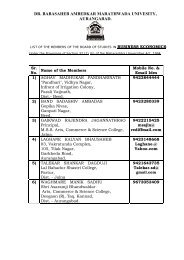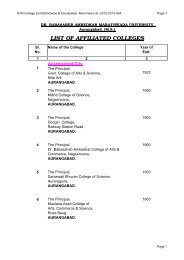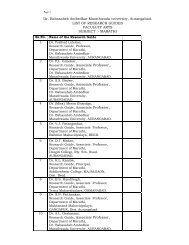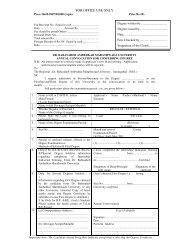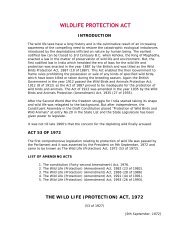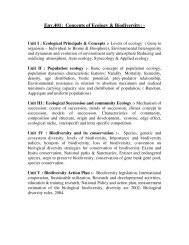DIPLOMA IN COMPUTER APPLICATION (DCA) ( As per credit ...
DIPLOMA IN COMPUTER APPLICATION (DCA) ( As per credit ...
DIPLOMA IN COMPUTER APPLICATION (DCA) ( As per credit ...
Create successful ePaper yourself
Turn your PDF publications into a flip-book with our unique Google optimized e-Paper software.
<strong>DIPLOMA</strong> <strong>IN</strong> <strong>COMPUTER</strong> <strong>APPLICATION</strong> (<strong>DCA</strong>)<br />
( <strong>As</strong> <strong>per</strong> <strong>credit</strong> system effective system )<br />
R-784 ( a ) The following shall be the scheme of examination<br />
Pap<br />
er<br />
No<br />
Title Weekly<br />
Th Pr<br />
I ICT Tools<br />
FIRST SEMESTER<br />
Credit<br />
Th Pr<br />
Marks<br />
Theory<br />
Marks<br />
Sessional<br />
or<br />
Practical<br />
S Pr<br />
Total<br />
Marks<br />
Duration<br />
Theory<br />
Exam<br />
3 4 3 2 60 40 100 2 Hrs<br />
II Computer<br />
Organisation &<br />
Architecture<br />
5 - 5 - 60 40 - 100 2 Hrs<br />
III C Programming 3 4 3 2 60 - 40 100 2 Hrs<br />
IV O<strong>per</strong>ating<br />
Systems<br />
V Soft Skills<br />
Development<br />
Total<br />
Pap<br />
er<br />
No<br />
3 4<br />
Title Weekly<br />
Th Pr<br />
3 2 60 - 40 100 2 Hrs<br />
5 - 5 - 60 40 - 100 2 Hrs<br />
19 12 19 + 6<br />
= 25<br />
300 80 120 500 --<br />
SECOND SEMESTER<br />
Credit<br />
Th Pr<br />
Marks<br />
Theory<br />
Marks<br />
Sessional<br />
or<br />
Practical<br />
S Pr<br />
Total<br />
Marks<br />
Duration<br />
Theory<br />
Exam<br />
VI OOPS using<br />
C++<br />
3 4 3 2 60 - 40 100 2 Hrs<br />
VII Management<br />
Process & OB<br />
5 - 5 - 60 40 - 100 2 Hrs<br />
VIII Data Structure<br />
using Java<br />
3 4 3 2 60 - 40 100 2 Hrs<br />
IX Database<br />
Management<br />
Systems<br />
3 4 3 2 60 - 40 100 2 Hrs<br />
X Project 6 3 - 100 100 -<br />
Total<br />
14 18 14 + 9<br />
= 23<br />
240 40 220 500 --<br />
Total Credits for Diploma (25 + 23 ) = 48
784 ( b ) The sessional marks assigned by institute/ college to the student shall be subject<br />
to the scaling down . The scanling down shall be done in relation to the theory marks. A<br />
variation ± 10% is <strong>per</strong>mitted.<br />
( c ) The university will appoint external examiner to assess the project. Both the<br />
examiners internal guide and external examiner shall assess the project report separately.<br />
On the basis of the following criteria:-<br />
1. Project Preparation 50 Marks<br />
2. Presentation 25 Marks<br />
3. Viva Voce 25 Marks<br />
Both the examiners shall submit the marks lists to the university separately. The average<br />
of both the examiners shall be taken as the marks obtained by the student in the project.<br />
The scaling down will not be applicable to the project marks.
PAPER I -- <strong>IN</strong>FORMATION COMMUNICATION TECHNOLOGY(ICT) TOOLS<br />
Unit I - ICT Fundamentals- Historical development –<br />
Theory 60<br />
Practical 40<br />
Credit 5<br />
Computer Programming Languages Classification, machine code, assembly language,<br />
higher lever languages, Single user, multi-user, work station, client server systems,<br />
Computer networks, network protocols, LAN,WAN, Internet facilities through WWW,<br />
Mosiac,Gopher, html and its elements<br />
Unit II - Word: Creating word documents, menu, office assistant working with<br />
files , editing text, saving, printing , undo, redo, spelling, formatting, ruler, selecting,<br />
cutting, copying, numbering, bullets, page, orientation, margins, tables in a document,<br />
formatting text in table, addition deletion of rows columns, record handling, sorting,<br />
label, & envelop, using forms, Recycle bin. Protection of documents, mail merge.<br />
Unit III - Excel: Excel Sheet creation, entering data, layout and formatting of sheet<br />
preview & print, working with range, rows, columns, total, sorting using formatting<br />
toolbars, format cells, cell content moving & coping grouped & ungrouped worksheet<br />
alignment of text, border colors, page setup, chart, types of chart merging sizing printing<br />
chart objects, formatting charts, formula palette , functions & uses - Analysing data with<br />
excel.<br />
4. Power Point: Creating a presentation, modifying visual elements, adding<br />
objects, applying transition, animation and linking, preparing layouts, presenting a slide<br />
show.<br />
Practicals:<br />
Familiarizing with DOS commands, Windows o<strong>per</strong>ating systems.<br />
Creating Documents inMSWORD<br />
Creating worksheets in MSEXCEL<br />
Developing Presentations with Power Point<br />
Web Page development in FRONT PAGE<br />
Books:-<br />
1. Courter Marquis - Office - 2000<br />
2. Mansfield - MS- Office<br />
3 Sanders - Computer Fundamentals<br />
3. Syber Publication - Office- 2000 Complete
PAPER II - <strong>COMPUTER</strong> ORGANIZATION AND ARCHITECTURE.<br />
Theory 60<br />
Sessional 40<br />
Credit 5<br />
Principles of Computer design – software, hardware interaction layers in computer<br />
architecture. Central processing unit. Machine language instructions, Addressing modes,<br />
instruction types, instruction set selection, Instruction cycle and execution cycle.<br />
Control unit, Data path and control path design, Microprogramming Vs hardwired<br />
control RISC Vs CISC, Pipelining in CPU designee Su<strong>per</strong>scalar processors.<br />
Memory system, Storage technologics, Memory array organization, Memory<br />
hierarchy, interleaving, cache and virtual memories and architectural aids to implement<br />
these.<br />
Input- Output devices and characteristics.<br />
Input-output processing, bus interface, data transfer techniques, I/O interrupts, channels<br />
<strong>per</strong>formance evaluation – SPEC marks, Transaction Processing benchmarks.<br />
Books:-<br />
Mano, M,” Computer System and Architecture” (3 rd edition) Prentice Hall of India, New Delhi,<br />
1994<br />
Pal Chauduri, p., “ Computer Organisation and Design”, Prentice Hall of India, New Delhi, 1994.<br />
Rajraman V., and Radhakrishnan, T., “ Introduction to Digital Computer Designee” (4 th edition),<br />
Prentice Hall of India, New Delhi, 1997.<br />
Stalling, W., “Computer Organization and Architecture. (2 nd edition) Prentice Hall of India, New<br />
Delhi.
PAPER III - C PROGRAMM<strong>IN</strong>G<br />
Theory 60<br />
Practical 40<br />
Credit 5<br />
1. C Language – Character set Tokens of C - tokens-constant-keywords and<br />
identifiers - variables- data types- declaration and assignment of variables-<br />
defining symbolic constants.- O<strong>per</strong>ators and Expressions:<br />
Types of O<strong>per</strong>ators- Arithmetic, Relational and Logical O<strong>per</strong>ators <strong>As</strong>signment,<br />
increment and decrement of o<strong>per</strong>ators - conditional bitwise and special o<strong>per</strong>ators -<br />
arithmetic expression and its evaluation - hierarchy of arithmetic o<strong>per</strong>ations -<br />
evaluations, precedence and associatively - mathematical functions.<br />
2. Control Branching and Decision-Making in C - If statement Switch statement -<br />
GOTO statement - The ? : O<strong>per</strong>ators.-<br />
3. Decision - Making and Looping nesting in a loop, statements in C WHILE DO,<br />
and FOR statements with variations.<br />
4. Arrays in C Single Two - dimensional and Multi-dimensional arrays.<br />
5. Handling of Character Set: Declaration & Initialization of string variables -<br />
reading from and writing to screen -Arithmetic o<strong>per</strong>ations - String handling<br />
functions.<br />
6. Structures and Unions:<br />
Definitions initialization and assigning values to members arrays of structures and<br />
arrays within structures structure with in structure- unions - size of structures.<br />
7. Pointers:<br />
Declaration and initialisation of pointers - pointer expression - pointer and arrays -<br />
pointer and character strings pointers and functions - pointers and structures<br />
pointer on pointers.<br />
8. File Maintenance in “C” :<br />
Defining, Opening and closing a file - Input/Output o<strong>per</strong>ations on a file- random<br />
access to file - command line arguments.<br />
9. User Defined Functions:<br />
Form of “C” functions- calling a function - nesting of functions - recursion -<br />
functions with arrays.<br />
Practicals:<br />
Writing Programs in C for various applications.<br />
File Handling Programs in C<br />
Books:<br />
1. Programming in “C” E Balgurusamy Tata Cm Graw-Hill<br />
2. The “C” Programming Language :Briain W. Kenigham & Dennis Ritchie<br />
3. The Spirit of “C”- Henrry Mulish, Herbert L. Coo<strong>per</strong>.<br />
4. Mastering “C” - Crain Bolon.
Pa<strong>per</strong> IV - O<strong>per</strong>ating Systems<br />
Theory 60<br />
Practical 40<br />
Credit 5<br />
Introduction<br />
Evolution of o<strong>per</strong>ating systems. Types of o<strong>per</strong>ating systems. Different Views of the<br />
o<strong>per</strong>ating systems, o<strong>per</strong>ating system concepts and structure.<br />
Processes<br />
The Process concept, systems programmer’s view of processes. The o<strong>per</strong>ating system<br />
services for process management, Scheduling algorithms. Performance evaluation.<br />
Memory Management<br />
Memory Management without swapping of paging, swapping, virtual memory page<br />
replacement algorithms, modeling paging algorithms, design issued for paging systems,<br />
segmentation.<br />
Inter-process Communication and Synchronization.<br />
The need for interprocess synchronization, natural exclusion., semaphores, hardware<br />
sport for mutual exclusion, queuing implementation of semaphores, classical problems in<br />
concern programming critical region and conditional critical region, monitors, messages<br />
deadlocks.<br />
File Systems.<br />
Field systems, directories, file systems implementation, security protection mechanism.<br />
Input/Output<br />
rinciples of I/O Hardware: I/O devices, devices controllers direct memory access.<br />
Principles of I/O Software: Goals, interrupt handlers, device drivers, device independent<br />
I/O software, User space I/O software.<br />
Disks. Disk hardware, scheduling algorithms, Error handling, trac-at-a-time caching,<br />
RAM Disk.<br />
Clocks: Clock hardware, memory mapped terminals, I/O software.<br />
Terminals: Terminal hardware memory mapped terminals, I/O software.<br />
Processes and Processors in Distributed Systems: Thready, system models, processor<br />
allocation scheduling.
Distributed File Systems: Design, implementation, and trends.<br />
Performance Measurement, monitoring and evaluation<br />
Introduction, important trends affecting <strong>per</strong>formance issue, why <strong>per</strong>formance monitoring<br />
and evaluation are needed, <strong>per</strong>formance measures, evaluation techniques, bottlenecks and<br />
saturation, feedback loops.<br />
Case Studies : MS, DOS,MS W<strong>IN</strong>DOWS, L<strong>IN</strong>UX(UNIX) o<strong>per</strong>ating systems.<br />
Practicals:- Commands and Shell of MS DOS, W<strong>IN</strong>DOWS, L<strong>IN</strong>UX / UNIX<br />
Books:<br />
Deitel H.M., “An Introduction to O<strong>per</strong>ating system”. Addison Wesley Publishing Company 1984.<br />
Milenkovic, M., “O<strong>per</strong>ating Systems – concepts and Design”, McGraw Hill International Edition<br />
Computer Science Series 1992.<br />
Peterson, J.L. Abraham Silberschatz. “ O<strong>per</strong>ating System Concepts “ Addison Wesley publishing<br />
Company 1989.<br />
Tanenbaum, A.s. “Modern O<strong>per</strong>ating System”, Prentice Hall of India Pvt. Ltd. 1995.
PAPER V - SOFT SKILL DEVELOPMENT<br />
Theory 60<br />
Sessional 40<br />
Credit 5<br />
1. Self Development and <strong>As</strong>sessment, Self-<strong>As</strong>sessment- Self-Awareness, Perception<br />
and Attitudes, Values and Belief System,<br />
Personal Goal Setting, Career Planning, Self-Esteem, Building of Self-Confidence<br />
2 Components of communication,<br />
Principles of communication, barriers, listening skills, Verbal Communication,<br />
Includes Planning, Preparation, Delivery,<br />
Feedback and <strong>As</strong>sessment of activities like Public speaking<br />
Group Discussion, Oral Presentation skills, Perfect Interview<br />
Listening and observation skills, Body language, Use of Presentation graphics, Use of<br />
Presentation aids, Study of communication.<br />
3. Written Communication, Technical Writing–Technical Reports<br />
Project Proposals, Brochures, Newsletters, Technical Articles<br />
Technical Manuals, Official/Business Correspondence- Business letters, Memos,<br />
Progress report, Minutes of meeting, Event reporting,<br />
Use of style,Grammar and Vocabulary for effective technical writing,<br />
Use of: Tools, Guidelines for technical writing, Publishing Ethics and Etiquettes,<br />
Business Ethics, Etiquettes in social as well as<br />
Office settings, Email etiquettes, Telephone Etiquettes, Engineering ethics and ethics<br />
as an IT professional, Civic Sense<br />
4. Other Skills- Managing time, Meditation, Understanding roles of<br />
Engineer and their Responsibility, Exposure to work environment And culture in<br />
today’s job Places, Improving Personal Memory,<br />
Study skills that include Rapid reading, Notes taking, Complex problem solving,<br />
creativity.
Books & Study Material:<br />
1. You Can Win – Shiv Khera – Macmillan Books – 2003 Revised Edition<br />
2. 7 Habits of Highly effective people – Stephen Covey<br />
3. Business Communication? <strong>As</strong>ha Kaul<br />
4. Business Communication - M. Balasubramanyam<br />
5. John Collin, “Perfect Presentation”, Video Arts MARSHAL<br />
6. Jenny Rogers “ Effective Interviews”, Video Arts MARSHAL<br />
7. Raman Sharma, “ Technical Communications”, OXFORD<br />
8. Sharon Gerson, Steven Gerson “Technical writing process and product”, Pearson<br />
Education <strong>As</strong>ia, LPE third edition.<br />
9. R. Sharma, K. Mohan, Business correspondence and report writing”, TAG McGraw<br />
Hill ISBN 0-07-044555-9<br />
10. 6. Video for technical education catalog, National education and Information Films<br />
Ltd. Mumbai.<br />
11. Management training and development catalog, National education and<br />
Information Films Ltd. Mumbai.<br />
12. XEBEC, “Presentation Book 1,2,3”, Tata McGraw-Hill, 2000,ISBN 0-40221-3<br />
13. Tim Hindle, “Reducing Stress”, Essential Manager series Dk Publishing<br />
14. Sheila Cameron, “Business student Handbook”, Pitman Publishing<br />
15. Dr. R. L. Bhatia, “ Managing time for competitive edge”<br />
16. Lorayne Lucas “Memory Book”<br />
17. Robert Heller, “Effective leadership”, Essential Manager series Dk Publishing<br />
18. Newstrom Keith Davis,” Organizational Behavior”, Tata McGraw-Hill, 0-07-.
PAPER VI - OBJECT ORIENTED PROGRAMM<strong>IN</strong>G US<strong>IN</strong>G C++<br />
Theory 60<br />
Practical 40<br />
Credit 5<br />
Introduction of OOPS, Procedural Vs Object Oriented Programming<br />
Classes, Object, Data Abstraction, Encapsulation, Inheritance, Polymorphism,<br />
Dynamic Binding, Message Passing, Object Oriented Languages, Basics of C++ -<br />
History of C & C++, V C++<br />
C++ Program Structure, Application of C++ Structure & Class<br />
Compiling & Linking- C++ Expression, C++ Tokens, Keywords, Identifiers &<br />
Constants, Basic Data Types, User-Defined Data Types,<br />
Symbolic Constant, Type Compatibility, Reference Variables, O<strong>per</strong>ator in C++, Scope<br />
Resolution O<strong>per</strong>ator, Member De-referencing O<strong>per</strong>ators, Memory Management<br />
O<strong>per</strong>ators,<br />
Manipulators, Type Cast O<strong>per</strong>ator<br />
Functions In C++, Main Function, Function Prototyping, Call by Reference, Call by<br />
Address, Call by Value, Return by Reference<br />
Inline Function, Default Arguments, Const Arguments, Function Overloading, Friend<br />
Function<br />
Classes & Object - C++ Program with class Defining Member Functions, Making an<br />
Outside Function Inline, Nesting of Member Functions, Private Member Functions<br />
Arrays within a Class- Memory Allocation for Objects<br />
Static Data Members, Static Member Functions, Arrays of Objects<br />
Object as Function Arguments, Friendly Functions, Returning Objects, Const member<br />
functions, Pointer to Members, Local Classes<br />
Constructor & Destructor- Parameterized Constructor Multiple Constructor in a Class,<br />
Constructors with Default Arguments, Dynamic Initialization of Objects, Copy<br />
Constructor, Dynamic Constructor, Const Object, Destructor<br />
O<strong>per</strong>ator Overloading & Type Conversion- Defining o<strong>per</strong>ator Overloading<br />
Overloading Unary O<strong>per</strong>ator Overloading Binary O<strong>per</strong>ator, Overloading Binary<br />
O<strong>per</strong>ator Using Friends, Manipulating of String Using O<strong>per</strong>ators, Type Conversion,<br />
Rules for Overloading O<strong>per</strong>ators<br />
Inheritance - Defining Derived Classes, Single Inheritance, Making a Private Member<br />
Inheritable, Multilevel Inheritance, Hierarchical Inheritance, Multiple Inheritance,
Hybrid Inheritance, Virtual Base Classes, Abstract Classes, Constructor in Derived<br />
Classes, Nesting of Classes<br />
Pointer, Virtual Function & Polymorphism, Introduction, Pointer to Object, Pointer to<br />
Derived Class, Virtual Function, Pure Virtual Function,<br />
C++ I/O System Basics- C++ Streams, C++ Stream Classes, Unformatted I/O<br />
O<strong>per</strong>ation, Formatted I/O O<strong>per</strong>ation, Managing Output with Manipulators<br />
Working with Files – Introduction, Classes for File Stream O<strong>per</strong>ation<br />
Opening & Closing Files, Detection of End of File, More about Open( ): File modes,<br />
File pointer & manipulator, Sequential Input & output O<strong>per</strong>ation, Updating a File :<br />
Random Access, Command Line Arguments<br />
Template- Generic Function, A function with Two Generic Data Types, Explicitly<br />
Overloading a Generic Function, Overloading a Function Template, Using Standard<br />
Parameter with Template<br />
Functions, Generic Function Restriction, Applying Generic Function : Generic Sort,<br />
Generic Classes, An Example with Two Generic Data Types, Using Non-Type<br />
Arguments with Generic Class, Using Default Arguments With Template Classes,<br />
Explicit Class, Specification,<br />
Exception handling - Exception Handling Fundamentals<br />
The try Block, the catch Exception Handler The throw Statements<br />
The try/throw/catch sequence Exception Specification Unexpected Exception Catch –<br />
All Exception Handlers Throwing an exception from handler Uncaught Exception<br />
Introduction to Standard Template Library- STL Programming Model, Sequence,<br />
Container Adapter, Integrator, lgorithms, Predicates, Allocators<br />
Books:<br />
1.C++: The Complete Reference Herbert Schildt<br />
2.Let us C++ Yeshwant Kanetkar<br />
3.Object Oriented Programming with C++ E. Balagurusamy<br />
4.C++ Primer Stanley Lippman & Lajoi<br />
5.C++ Programming Language Bjarne Stroustrup<br />
6.C++ Programming Bible Al Stevens & Clayton Walnum
PAPER VII - MANAGEMENT PROCESS & ORGANISATIONAL<br />
BEHAVIOUR<br />
Theory 60<br />
Sessional 40<br />
Credit 5<br />
Introduction of mangement , Evolution of management thought, Systems and<br />
contingency approach for understanding organizations, managerial processes, functions,<br />
skills and roles in an organization; Social Responsibility of Business; Understanding and<br />
Managing Individual behaviour- Personality, Perceptions, Values, Attitudes, Learning,<br />
Work motivation, Individual decision making and problem solving; Understanding and<br />
managing group processes-Inter<strong>per</strong>sonal and group dynamics applications of emotional<br />
intelligence in organizations, communication, group decision making, Leadership and<br />
influence process; Understanding and Managing organizational system-Organizational<br />
design and structure, Work stress.<br />
BOOKS:<br />
1. Koonz, H. and Weachirch, H. Management. 10 th ed., New York, McGraw Hill,<br />
1995.<br />
2. Luthans, F. Organizational Behaviour, 7 th ed., New York, McGraw Hill, 1995.<br />
3. Robbins, S.P. Management, 5 th ed., New Jersey, Englewood Cliffs, Prentice Hall<br />
Inc., 1996.<br />
4. Robbins, S.P. Organizational Behaviour, 7 th ed., New Delhi, Prentice hall of<br />
India, 1996<br />
5. Singh, Dalip Emotional Intelligence at work, Response Books, Sage Publications,<br />
Delhi, 2001.<br />
6. Staw, B.M. Psychological Dimensions of Organizational Behaviour.2 nd Ed.,<br />
Englowed Cliffs, New Jersey, Prentice Hall Inc. 1995.<br />
Stoner, J. etc. Management 6 th Ed., New Delhi, Prentice Hall of India, 1996.
PAPER IX DATABASE MANAGEMENT SYSTEM<br />
Theory 60<br />
Practical 40<br />
Credit 5<br />
1. Database Management System- Basic concepts, Data base & Database users<br />
Characteristics of Database, Database systems, concepts and architecture<br />
Date Models, Schemas & Instances DBMS Architecture & data independence<br />
Data base languages & Interfaces, Data modeling using the entity-relationship approach<br />
2. Relational Model, Languages & Systems, Relational data model & Relational Algebra<br />
Relational Model Concepts<br />
Relational Model Constraints<br />
Relational Algebra<br />
SQL – A Relational Data base language<br />
Date Definition in SQL<br />
View & queries in SQL<br />
Specifying constraints & indexes in SQL<br />
Specifying constraints & indexes in SQL<br />
A relational database management systems<br />
ORACLE / <strong>IN</strong>GRES<br />
3. Conventional data models & systems<br />
Network Data model & IDMS systems<br />
Membership types and options in a set<br />
DML for network model<br />
Navigation within a network database<br />
Hierarchical Data model & IMS system<br />
Hierarchical Database structure<br />
HSAM, HISM, HDAM & HIDAM organization<br />
DML for Hierarchical model<br />
Overview of IMS<br />
4. Relational database design<br />
Function Dependencies & normalization for relational Databases<br />
Function Dependencies<br />
Normal forms based on primary keys<br />
(1NF,2NF,3NF & BCNF)<br />
Lossless jooin & dependency preserving decomposition
5. Concurrency control & Recovery Techniques<br />
Concurrency control Techniques<br />
Locking Techniques<br />
Time stamp ordering<br />
Gravularity of data items<br />
Recovery Techniques<br />
Recovery concepts<br />
Database backup and recovery from catastrophic failures<br />
6. Concepts of object oriented data base management systems<br />
Books :<br />
Date , C.J. “An introduction to database systems”, Narosa Publishing House, New Dehli<br />
Desai, B. “An introduction to database concepts”, Galgotia publications, New Dehli<br />
Elmsari and cavathe, “fundamental of database systems “, addison wesley, New York<br />
Ullamn, J.D. “principles of database systems”, Galgotia publications, New Dehli
PAPER X - PROJECT<br />
Marks 100<br />
Credit 3<br />
Each student has to complete a project in second semester. The project will be assigned<br />
by the internal guide from the institute. <strong>As</strong> far as possible individual projects are to<br />
allotted to students. However, in case of larger project two or three student work in<br />
group. In such a case each student should work on a separate or distinct module. Student<br />
should submit the project individually. The project report submitted by the student shall<br />
be evaluated separately by the internal guide and the external examiner appointed by the<br />
university. Project work may be carried out in the institution or outside with prior<br />
<strong>per</strong>mission of the institute.


